
Alessandro di Mariano di Vanni Filipepi, better known as Sandro Botticelli or simply Botticelli, was an Italian painter of the Early Renaissance. Botticelli's posthumous reputation suffered until the late 19th century, when he was rediscovered by the Pre-Raphaelites who stimulated a reappraisal of his work. Since then, his paintings have been seen to represent the linear grace of late Italian Gothic and some Early Renaissance painting, even though they date from the latter half of the Italian Renaissance period.

Filippino Lippi was an Italian painter working in Florence, Italy during the later years of the Early Renaissance and first few years of the High Renaissance.

BartolomeoMontagna was an Italian Renaissance painter who mainly worked in Vicenza. He also produced works in Venice, Verona, and Padua. He is most famous for his many Madonnas and his works are known for their soft figures and depiction of eccentric marble architecture. He is considered to be heavily influenced by Giovanni Bellini, in whose workshop he might have worked around 1470. Benedetto Montagna, a productive engraver, was his son and pupil and active until about 1540. He was mentioned in Vasari's Lives as a student of Andrea Mantegna but this is widely contested by art historians.

Filippo Lippi, also known as Lippo Lippi, was an Italian painter of the Quattrocento and a Carmelite priest. He was an early Renaissance master of a painting workshop, who taught many painters. Sandro Botticelli and Francesco di Pesello were among his most distinguished pupils. His son, Filippino Lippi, also studied under him and assisted in some late works.
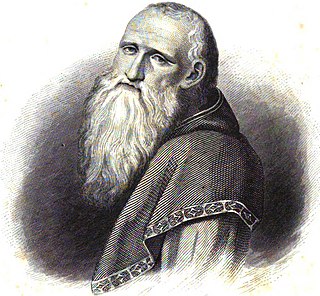
Bernardino Luini was a north Italian painter from Leonardo's circle during the High Renaissance. Both Luini and Giovanni Antonio Boltraffio were said to have worked with Leonardo directly; he was described as having taken "as much from Leonardo as his native roots enabled him to comprehend". Consequently, many of his works were attributed to Leonardo. He was known especially for his graceful female figures with elongated eyes, called Luinesque by Vladimir Nabokov.
Andrea Solari (1460–1524) was an Italian Renaissance painter of the Milanese school. He was initially named Andre del Gobbo, but more confusingly as Andrea del Bartolo a name shared with two other Italian painters, the 14th-century Siennese Andrea di Bartolo, and the 15th-century Florentine Andrea di Bartolo.

Giovanni Battista Cima, also called Cima da Conegliano, was an Italian Renaissance painter, who mostly worked in Venice. He can be considered part of the Venetian school, though he was also influenced by Antonello da Messina, in the emphasis he gives to landscape backgrounds and the tranquil atmosphere of his works. Once formed his style did not change greatly. He mostly painted religious subjects, often on a small scale for homes rather than churches, but also a few, mostly small, mythological ones.
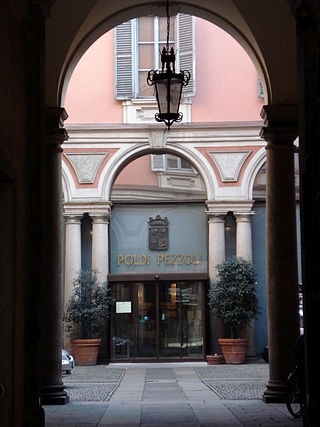
The Museo Poldi Pezzoli is an art museum in Milan, Italy. It is located near the Teatro alla Scala, on Via Manzoni 12.
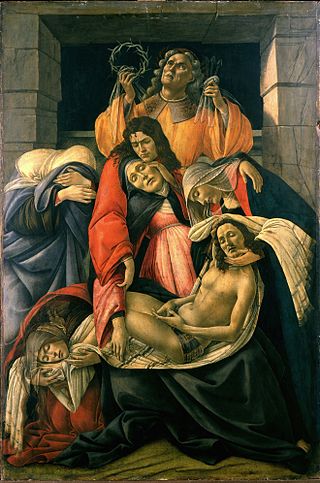
The Lamentation over the Dead Christ with Saints is a painting of the Lamentation of Christ by the Italian Renaissance artist Sandro Botticelli, dated between 1490 and 1495. The painting was originally kept in Santa Maria Maggiore, Florence. It is now in the Museo Poldi Pezzoli of Milan. The painting is one of two versions of The Lamentation by Botticelli. The other, circa 1492, is now in the Alte Pinakothek in Munich.

Giovanni Antonio Boltraffio was an Italian painter of the High Renaissance from Lombardy, who worked in the studio of Leonardo da Vinci. Boltraffio and Bernardino Luini are the strongest artistic personalities to emerge from Leonardo's studio. According to Giorgio Vasari, he was of an aristocratic family and was born in Milan.
The decade of the 1460s in art involved some significant events.
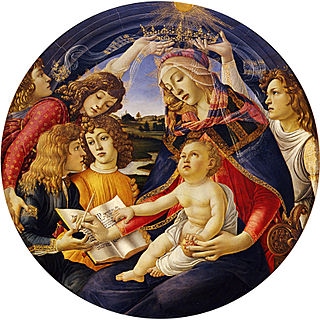
The Madonna of the Magnificat, is a painting of circular or tondo form by the Italian Renaissance painter Sandro Botticelli. It is also referred to as the Virgin and Child with Five Angels. In the tondo, we see the Virgin Mary writing the Magnificat with her right hand, with a pomegranate in her left, as two angels crown her with the Christ child on her lap. It is now in the galleries of the Uffizi, in Florence.
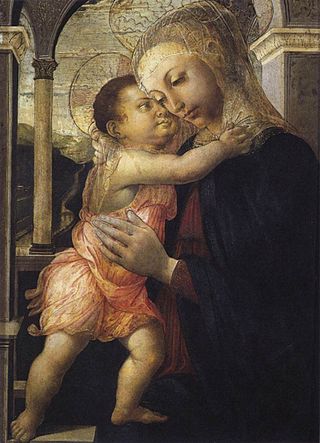
The Madonna della Loggia is a painting attributed to the Italian Renaissance artist Sandro Botticelli, dating to c. 1467. A tempera on panel work, it is located in the loggia of Uffizi, Florence, Italy.

Cristoforo Moretti was a Lombard painter of the quattrocento who worked in a late International Gothic style very similar to that of Michelino da Besozzo’s last period. Few of the unsigned works later attributed to him are attributed with perfect certainty.
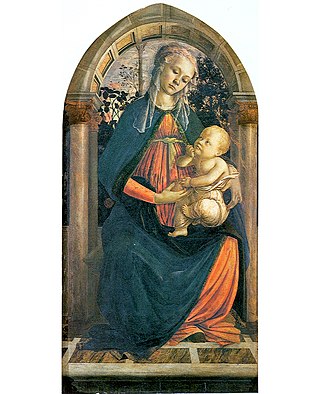
The Madonna of the Rose Garden is a tempera on panel painting made by Sandro Botticelli, whose date of between 1469 and 1470 makes it one of his earliest paintings. It is now in the Uffizi Gallery in Florence, Italy.

Profile Portrait of a Young Lady is a 1465 half-length portrait, made with oil-based paint and tempera on a poplar panel, usually attributed to Antonio del Pollaiuolo, although the owning museum, the Gemäldegalerie in Berlin, now describes this work as by his brother Piero del Pollaiuolo, and as one of its most famous paintings, and as one of the most famous portraits of women from the early Italian Renaissance.

The Poldi Pezzoli Madonna or Madonna with the Sleeping Christ Child is a tempera on canvas painting by Andrea Mantegna, dating to around 1490-1500, after the painter's trip to Rome. It was bought from Giovanni Morelli's collection by Gian Giacomo Poldi Pezzoli shortly after the 1850s and is now in the Museo Poldi Pezzoli in Milan. It was restored in 1863 by Giuseppe Molteni, who added the varnish which has now yellowed.
Pezzoli may also refer to:

Portrait of a Young Woman is a mixed-technique painting on panel of c. 1470–1472, variously attributed to Piero del Pollaiuolo or his brother Antonio. It is now in Milan in the Museo Poldi Pezzoli, which uses the painting as its symbol.

















